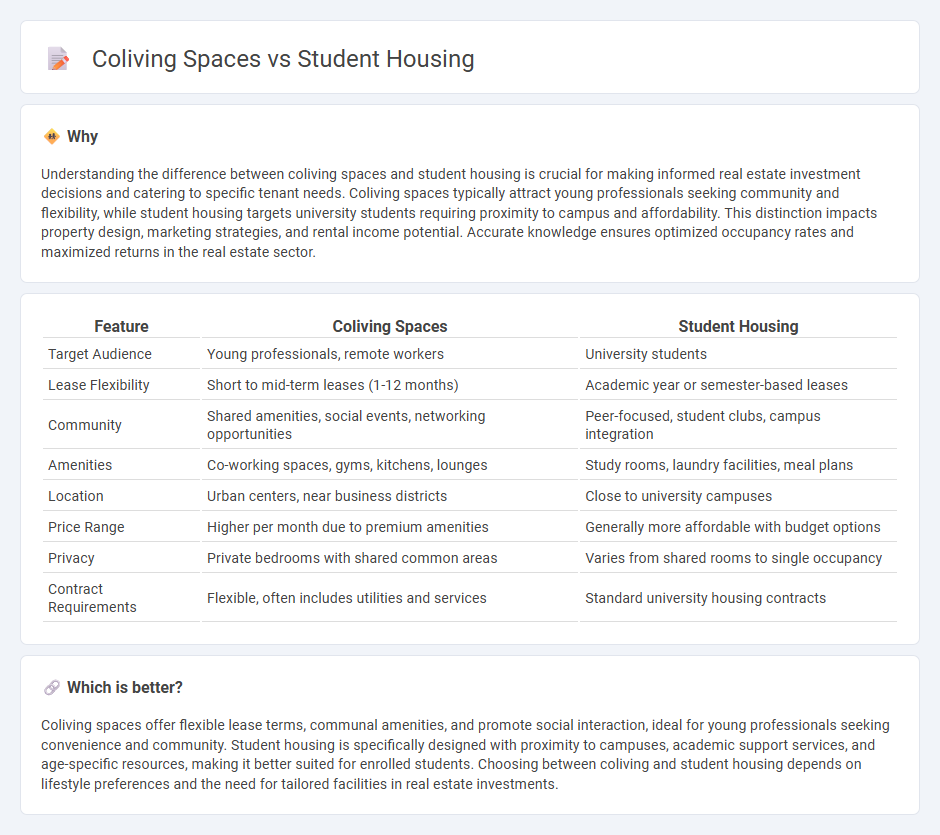
Coliving spaces offer flexible leases, modern amenities, and a community-oriented lifestyle appealing to young professionals and digital nomads, while student housing focuses on affordability, proximity to campuses, and study-friendly environments tailored to academic schedules. Research shows coliving occupancy rates have grown by 25% annually, reflecting increasing demand for shared living solutions beyond traditional dorms. Explore how coliving and student housing cater to evolving real estate needs and lifestyle preferences.
Why it is important
Understanding the difference between coliving spaces and student housing is crucial for making informed real estate investment decisions and catering to specific tenant needs. Coliving spaces typically attract young professionals seeking community and flexibility, while student housing targets university students requiring proximity to campus and affordability. This distinction impacts property design, marketing strategies, and rental income potential. Accurate knowledge ensures optimized occupancy rates and maximized returns in the real estate sector.
Comparison Table
| Feature | Coliving Spaces | Student Housing |
|---|---|---|
| Target Audience | Young professionals, remote workers | University students |
| Lease Flexibility | Short to mid-term leases (1-12 months) | Academic year or semester-based leases |
| Community | Shared amenities, social events, networking opportunities | Peer-focused, student clubs, campus integration |
| Amenities | Co-working spaces, gyms, kitchens, lounges | Study rooms, laundry facilities, meal plans |
| Location | Urban centers, near business districts | Close to university campuses |
| Price Range | Higher per month due to premium amenities | Generally more affordable with budget options |
| Privacy | Private bedrooms with shared common areas | Varies from shared rooms to single occupancy |
| Contract Requirements | Flexible, often includes utilities and services | Standard university housing contracts |
Which is better?
Coliving spaces offer flexible lease terms, communal amenities, and promote social interaction, ideal for young professionals seeking convenience and community. Student housing is specifically designed with proximity to campuses, academic support services, and age-specific resources, making it better suited for enrolled students. Choosing between coliving and student housing depends on lifestyle preferences and the need for tailored facilities in real estate investments.
Connection
Coliving spaces and student housing both cater to affordable, community-focused living solutions that emphasize shared amenities and social interaction among residents. These housing models optimize urban real estate by maximizing occupancy through flexible leasing terms designed for transient populations like students and young professionals. The integration of coliving concepts in student housing developments enhances convenience and fosters collaborative environments that support academic and personal growth.
Key Terms
Lease Structure
Student housing leases typically involve fixed-term agreements aligned with academic calendars, often spanning 9 to 12 months. Coliving spaces offer more flexible lease structures, including month-to-month options designed to accommodate transient lifestyles and varying tenancy durations. Explore how these lease variations impact your living experience and financial commitments.
Occupancy Model
Student housing typically operates on a fixed-term lease occupancy model, ensuring stable, long-term commitments aligned with academic calendars. Coliving spaces adopt a flexible, month-to-month occupancy model that caters to transient residents seeking community-oriented living and adaptable lease terms. Explore the detailed differences in occupancy models to determine which housing solution best suits your lifestyle and needs.
Amenities
Student housing typically offers essential amenities such as study rooms, laundry facilities, and high-speed internet tailored to academic needs, whereas coliving spaces provide more communal features like shared kitchens, social lounges, and wellness centers designed to foster community engagement. Both housing options emphasize security and maintenance services, but coliving often includes flexible lease terms and lifestyle-oriented perks like organized events and coworking areas. Explore the differences in amenities further to choose the best living environment that supports your lifestyle and academic success.
Source and External Links
Apartments - Campus Living - University at Buffalo - Offers on-campus apartments with furnished living spaces, full kitchen amenities, and convenient access to campus facilities.
Student Apartments in Buffalo, NY - American Campus Communities - Provides off-campus apartments near the University at Buffalo with private bedrooms and modern amenities like pools and fitness centers.
Off Campus Housing For International Students | The Station Buffalo - Offers furnished off-campus housing with amenities like study areas and roommate matching services within walking distance to UB North Campus.
 dowidth.com
dowidth.com